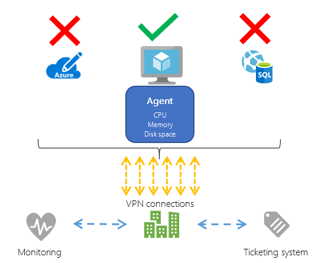Running workloads in Azure and using those related services is one thing – how do you actually look after these services while simultaneously driving your cloud journey forwards in an optimal fashion?
I thought I’d start this blog post off with a few stats – because who doesn’t love a stat?
- More than 90% of organizations will be using some form of the cloud (Source: 451)
- IaaS is the fastest growing cloud spending service with a five-year CAGR of 33.7%. (Source: IDC)
- PaaS spending will be the second-fastest growing category (29.8% CAGR) (Source: IDC)
What we’re getting at here is cloud usage is an inevitability for most major organisations. But running workloads in Azure and using those related services is one thing – how do you actually look after these services while simultaneously driving your cloud journey forwards in an optimal fashion?
Traditionally looking after our workloads has involved the use of agents, collecting metrics, and then performing an action against a particular threshold that has been pre-defined. A traditional solution shown below is an incredibly common scenario. But in the new world of Azure this has some severe limitations around the Azure platform itself, especially non virtual machine-based services.

As part of the customers cloud journey, sooner or later they will be making use of services away from traditional virtual machines. Even virtual networking in Azure is something you’d want to track – but how? And while we’re at it, how do we track new deployments and monitor and manage them as well without getting our hands dirty?
These are the questions we posed ourselves on the development team for our Azure Autonomous Cloud management solution for customers. With the use of Autonomous Cloud, we immediately extend the management and monitoring capabilities to the Azure activity log, Azure IaaS VMs and associated resources as well as PaaS services such as PaaS SQL databases and Web Apps.
The reason this is possible is that Autonomous Cloud is a solution that has been designed to work on Azure from ground up to analyse Azure specific resources. their output and has the ability to raise alerts automatically and proactively unlike the vast majority of management and monitoring solutions which only monitor VMs and are on-premises orientated. The best bit? this is designed by technical consultants with combined years of Azure experience with our customers – and we’re constantly adding new resources and features.
In addition, Autonomous Cloud runs on Azure itself, meaning no VMs or single points of failure. By tightly integrating with the Azure ecosystem we can rely on the Azure SLAs for services as opposed to having to patch and monitor our own hardware. All our integration and monitor capabilities use secured HTTPS connections – meaning no messy VPNs for monitoring to manage or worry about.
So how does this work?
When we onboard your Azure subscription, Autonomous Cloud performs an initial subscription level scan of your resources and catalogues what’s in use against our supported resources. Using this information, pre-defined monitoring rules are deployed and configured based on the resources detected in Azure from our bank of rules. This bank of rules is being added to all the time but is based on customer feedback and our Azure experience from all our engagements to make sure you’re getting the best monitoring and management of your resources. All the rules are automatically pre-configured with the ability to raise tickets with our ITSM solution manned by Azure certified personnel – all without any manual configuration whatsoever. The added benefit using automation here is this dramatically speeds up the onboarding process over a traditional deployment.

What about new resources?
If you spin up new resources that are on our support list for Autonomous Cloud, we use automation processes to scan the Azure subscription once a day for those new resources compared to 24 hours before. If new resources are discovered, they are automatically onboarded for monitoring and management. These resources are also automatically discovered and logged in our ITSM solution - no manual intervention required.

And thresholds?
Like a normal management and monitoring solution we use pre-defined thresholds to perform alerting on services, such as consistently high CPU on an Azure VM for example. But we also make use of dynamic thresholding to provide a more reliable experience where applicable. Using machine learning dataset analysis, Autonomous Cloud will review certain load types, such as disk IO, and determine where the threshold resides itself. As every disk and workload is different in this example, this means more accurate alerting over a traditional solution.

Sounds good! – how do I find out more?
This is just one area of many that Autonomous Cloud can assist with your Azure solution and cloud adoption strategy. Be sure to keep an eye on the blog for further upcoming technical area, and how here at Ultima we can help your organisation become part of those industry stats.
Check out our previous blog for a more complete overview on Autonomous Cloud as well as our introductory datasheet.
 Written by Chris Kirk, Cloud Development Team Lead
Written by Chris Kirk, Cloud Development Team Lead


